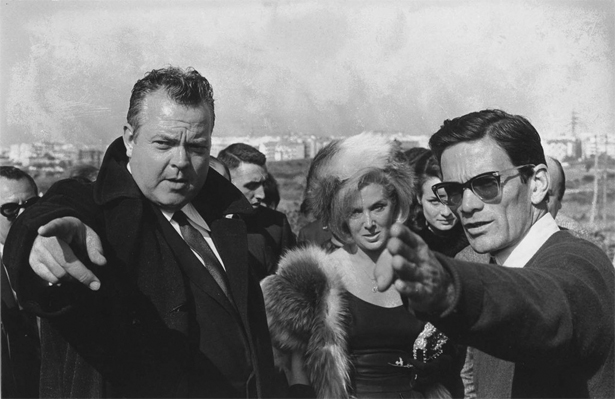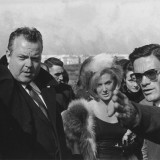Right from the choice of the title – The Ricotta – Pasolini kicks off an onslaught of symbols to convey his dissatisfaction with the dull consumerism of Italian society during the economic boom of early 60’s. To his belief, the government along with the church banded together to exploit the poor. A prophet ahead of his time, but the way he expressed his ideas alienated people left and right, secular or religious.
 Pasolini and Welles on the set. Interestingly Welles at the time had no clue who Pasolini was
Pasolini and Welles on the set. Interestingly Welles at the time had no clue who Pasolini was
How he was able to muster it, you ask? Pasolini was on one hand an atheist that used this short film about the Passion of Jesus he grandly believed its scriptures. Yet, deplored the way the Roman Catholic church maltreated the poor and operated as a commercial operation in collaboration with the government.
And on the political side, he was a communist, that believed that the communists did not follow their ideals of equal treatment of people and cared more about their well-being than the poor. Because to his belief only the poor represent the true values of a man. We can see this sentiment manifested in a wide range of past works such as Ragazzi di vita (Boys of Life), Accatone, Mamma Roma and others.
Pasolini was also gay in a time where it was not very understood. All the above culminated to his murder in 1975, that to this day still remains an unsolved mystery.
This short film, the most memorable from an omnibus film – RoGoPaG (AKA Ro.Go.Pa.G.) with shorts from other prominent directors: Roberto Rossellini, Jean-Luc Godard, and less known Ugo Gregoretti – tells the story of a poor extra Stracci in a film within a film story.
Now that you have the message of the film, let’s peel this “multi-layered onion” and see how Pasolini is communicating it, which is quite astounding for a short film (will try to do it without revealing too much):
- Title: As I mentioned, Pasolini initiates his message right from the title of the film: La ricotta – the most simple cheese type that is typically consumed by the poor. The cheese is made from goat cheese, which again represents the naive nature of the poor mulled by the powerfuls. Ricotta literally means cooked twice. which can give you some inklings about the poor Stracci that not only had a miserable life, his fate is unforgiving either.
- Stracci: The role of Stracci which means rugs, paints the robust values of the poor who care for their family first before themselves. Their shrewdness to improvise to make a living. And within the Passion of Jesus film, Stracci plays the Good Thief, which again is an ironic statement. Stracci always uses a nearby cave to hide his lunch and as such is reduced to a cave man, that at some point is ridiculed by the other actors as he stuffs his face almost like a rare exhibit. The choice of a cave is also interesting. The proletariat settles for life underground, which is in a way reminiscent of 1927’s Metroplis by Fritz Lang, a futuristic film, depicting the rich industrialists oppressing the poor who live under ground in workers city.
- Set:
 The film was shot in Rome in a field between Via Ampia Antica and Via Ampia Nuova to convey this “twilight zone” of decadence of Italian society. This dissonance between the positive old and negative new is augmented in the crown scene by showing in the horizon the new buildings for the poor popping up (what we call “the projects”), thus adding an apocalyptic flare.
The film was shot in Rome in a field between Via Ampia Antica and Via Ampia Nuova to convey this “twilight zone” of decadence of Italian society. This dissonance between the positive old and negative new is augmented in the crown scene by showing in the horizon the new buildings for the poor popping up (what we call “the projects”), thus adding an apocalyptic flare. - Soundtrack: The film starts with a modern twist music, where we see actors in their old garb dancing to a music that back then was still considered unconservative – underscoring the corrupted modern society hedonism quest. The choice of Dies Irae – a latin requiem, when we Stracci’s family is eating in the field – to mourn the passing of old values. Sempre Libera (Always Free) from Verdi’s La Traviata, when we see the press, celebs, and the rich congregate to express their detachment and their sole interest to have fun. Whenever we see Stracci runs, the music turns jovial, and the stopmotion technique that offers a Chaplinsque feel to his haplessness
- Orson Welles: Pasolini uses Welles (plays the director for the film in film) as his mouth in this film to convey his message that is eloquently articulated in the interview he conducts with the journalist. Welles allowed the journalist only 4 questions, and finishes the interview by disparaging remarks about the fact that the journalist representing the average nobody didn’t understand anything and so in fact doesn’t exist.
- Colors:
 Whenever we see the film in film of the Passion of Jesus being shot, the screen turns into bold colors, echoing Italian Renaissance painters such as Pontormo and Fiorentino, that represent exaggerated false reality. This technique is juxtaposed with the black and white scenes where Stracci appears to convey the true reality of the poor who needs to make tough decisions every day
Whenever we see the film in film of the Passion of Jesus being shot, the screen turns into bold colors, echoing Italian Renaissance painters such as Pontormo and Fiorentino, that represent exaggerated false reality. This technique is juxtaposed with the black and white scenes where Stracci appears to convey the true reality of the poor who needs to make tough decisions every day
Now that you have the premise, the message, and the tactics Pasolini used, play it forward to the present, do you agree with Pasolini’s prophecy? Is it still true today? What is your take?
Beyond the message, I find the film as a great evidence to the powerful and rich canvas the cinematic medium offers directors to express their ideas. The story is just the context, but the content ingredients (e.g., sound, picture, script etc.) carry their independent messaging channel.
You can watch the 34 minutes film in its entirety right here (with English subtitles):
[youtube width=”650″ height=”461″]http://youtu.be/U-FxFN0VTAE[/youtube]

